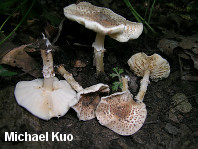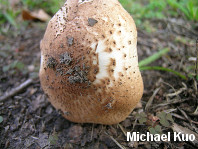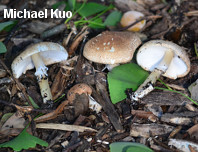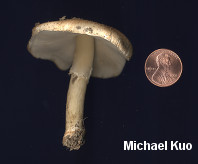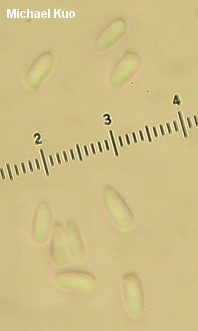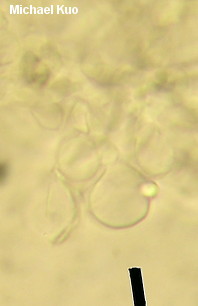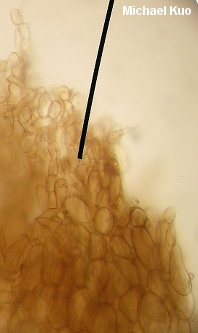| Major Groups > Gilled Mushrooms > Pale-Spored > Lepiotoid Mushrooms > Lepiota asperula |

|
Lepiota asperula [ Basidiomycota > Agaricales > Agaricaceae > Lepiota . . . ] by Michael Kuo First described in 1900 by pioneer American mycologist George Atkinson, Lepiota asperula is virtually identical to the better-known Lepiota aspera--but is, on average, smaller. More definitively, Lepiota asperula has much smaller spores that measure under 6 µ long; the spores of Lepiota aspera are about 6-10 µ long. Atkinson described Lepiota asperula from Ithica, New York, but the species has since been documented throughout eastern North America. Attempts to identify Lepiota asperula with European literature arrive at Lepiota echinacea, which is very similar, and which Helen Smith (1954) suspected as possibly identical. She called for "careful study at the monographic level" of the small-spored, aspera-like species--and, more than 60 years later, the world still awaits such a study. Lepiota eriophora is similar but often even smaller; it is a darker brown, and its stem is sheathed with brown tomentum. Under the microscope it has even smaller spores and lacks clamp connections. Description: Ecology: Saprobic; growing alone or scattered in hardwood forests; summer and fall; widely distributed east of the Rocky Mountains. The illustrated and described collections are from Illinois. Cap: 2-5 cm across; convex at first, becoming broadly convex or flat in age, but retaining a shallow central bump; dry; when young densely covered with soft fibers that separate with development and become aggregated into small, sharp scales with maturity; reddish brown to pinkish brown overall when young; when mature with dark brown scales over a whitish to beige ground color. Gills: Free from the stem; crowded; short-gills frequent; white; at first covered by a white partial veil that is dotted with small scales like the cap. Stem: 3-6 cm long; up to about 1 cm thick; more or less equal; dry; finely hairy; with a ragged, flimsy, white ring; whitish to pale brownish; adorned with brownish to reddish fibrils near the base; hollowing. Flesh: White; not changing when sliced. Odor: Fragrant. Chemical Reactions: KOH negative on cap surface. Spore Print: White. Microscopic Features: Spores 3.5-5.5 x 1.5-2.5 µ; long-ellipsoid to cylindric; occasionally with a flattened basal end; smooth; hyaline in KOH; dextrinoid; tending to cohere in groups when free floating. Cheilocystidia 20-25 x 5-12 µ; sphaeropedunculate to widely clavate; septate; hyaline in KOH; thin-walled. Pleurocystidia absent. Pileipellis an interwoven layer of cylindric hyphae REFERENCES: G. F. Atkinson, 1900. (Kauffman, 1918; Kauffman, 1924; H. V. Smith, 1954.) Herb. Kuo 08030401, 10040505, 10191401. This site contains no information about the edibility or toxicity of mushrooms. |
© MushroomExpert.Com |
|
Cite this page as: Kuo, M. (2015, September). Lepiota asperula. Retrieved from the MushroomExpert.Com Web site: http://www.mushroomexpert.com/lepiota_asperula.html |
